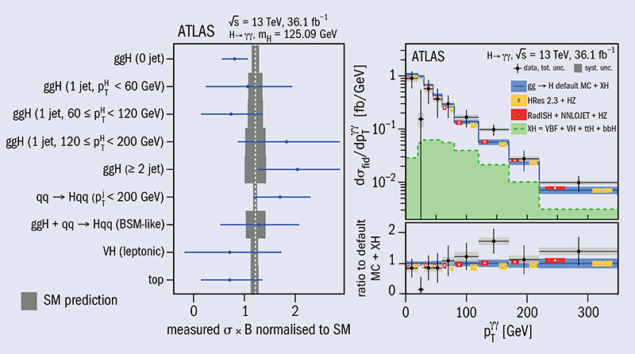
The ATLAS collaboration has released a set of comprehensive results that illuminates the properties of the Higgs boson with improved precision, using its decay into two photons with LHC collisions recorded at a centre-of-mass energy of 13 TeV.
The Higgs-to-two-photons decay played a crucial role in the discovery of the Higgs boson in 2012 owing to the excellent mass resolution and well-modelled backgrounds in this channel. Following the discovery, the properties of the Higgs boson can be probed more precisely using the large 13 TeV dataset.
One major result of the new study is the measurement of the signal strength μ, defined as the ratio of the number of observed and expected Higgs boson events. The signal strength is measured to be μ = 0.99+0.15–0.14 – in good agreement with the Standard Model expectation. The precision could be improved by a factor of two with respect to the previous measurements at energies at 7 and 8 TeV. The precision of signal-strength measurements of individual Higgs boson production modes are also improved significantly thanks to a better understanding of the ATLAS detector, the increased rate of Higgs production at 13 TeV and the extended use of machine-learning techniques to identify specific production processes.
Another key result of the present study are the measurements of nine simplified template cross sections (STXS), which refer to the cross sections of specific Higgs production channels measured in different kinematic regions. Measurements of STXS are corrected for the impact of the Higgs-boson decay and incorporate the acceptance of the experiment, so that they can be combined across Higgs boson channels and experiments (see figure, left).
The properties of the Higgs boson are further investigated by measuring 20 differential and two double-differential cross sections. The Higgs boson transverse momentum (figure, right) and rapidity, the number and properties of jets produced in association with the Higgs boson, and several angular relations that allow us to probe its spin and CP quantum numbers are measured. Five of these distributions are used to search for new CP-even and CP-odd couplings between the Higgs boson and vector bosons or gluons. No significant deviations from the Standard Model predictions are observed.
Collectively, this new set of results at the highest LHC energies sheds light on the fundamental properties of the Higgs boson and extends our knowledge obtained from the first running period of the LHC.
Further reading
ATLAS Collaboration 2018 arXiv:1802.04146.





